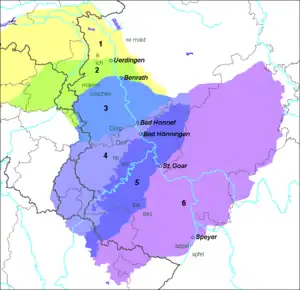Rhenish fan
The subdivision of West Central German into a series of dialects, according to the differing extent of the High German consonant shift, is particularly pronounced. It known as the Rhenish fan (German: Rheinischer Fächer, Dutch: Rijnlandse waaier) because on the map of dialect boundaries, the lines form a fan shape.[1] Here, no fewer than eight isoglosses, named after places on the Rhine River, run roughly west to east. They partially merge into a simpler system of boundaries in East Central German. The table below lists the isoglosses (bold, in light fields) and the main resulting dialects (italics, in dark fields), arranged from north to south.
Chart

The Rhenish fan:
Low Franconian:
1 North Low Franconian
2 South Low Franconian
West Central German:
3 Ripuarian Franconian
4 & 5 Mosel Franconian
6 Rhenish Franconian
Low Franconian:
1 North Low Franconian
2 South Low Franconian
West Central German:
3 Ripuarian Franconian
4 & 5 Mosel Franconian
6 Rhenish Franconian
| Dialects and isoglosses of the Rhenish fan (Arranged from north to south: dialects in dark fields, isoglosses in light fields)[n 1][2][3] | ||
| North Low Franconian (Kleverlandish, East Bergish) / Low Saxon | ||
|---|---|---|
| Uerdingen line (Uerdingen) (Ürdinger Linie) |
ik/ick | ich |
| South Low Franconian (Limburgish) | ||
| Benrath line (Benrather Linie) (Boundary: Low German — Central German) |
maken | machen |
| Ripuarian Franconian (Cologne, Bonn, Aachen) | ||
(Dorp/Dorf-Linie or Eifel-Schranke/Eifelschranke) (State border NRW–RP) |
Dorp | Dorf |
| Northern Mosel Franconian (Luxemburgish, Trier) | ||
| up | uf | |
| Southern Mosel Franconian (Koblenz, Saarland) | ||
| Bacharach line (Bacharach) (dat/das-Linie or Hunsrück-Schranke/Hunsrückschranke or Bacharacher Linie) |
dat, wat | das, was |
| Rhenish Franconian (Pfälzisch, Frankfurt) | ||
| Speyer line (Speyer) (Speyrer Linie) (Boundary: Central German — Upper German) |
Appel | Apfel |
| Germersheim line (Germersheim) (Germersheimer Linie) (Boundary: Central German — Upper German) |
Pund | Pfund |
| Upper German | ||
Notes
- That is, it's arranged like this:
northern dialect Isogloss northern form southern form southern dialect
References
- Rheinischer Fächer – Karte des Landschaftsverband Rheinland Archived February 15, 2009, at the Wayback Machine
- LVR-Institut für Landeskunde und Regionalgeschichte (ed.). "Dialekte im Rheinland". Archived from the original on 7 December 2022. Retrieved 21 July 2023.. Compare also:
- LVR-Institut für Landeskunde und Regionalgeschichte (ed.). "Dialekte im Rheinland". Retrieved 21 July 2023.
- LVR-Institut für Landeskunde und Regionalgeschichte (ed.). "Kleverländisch/ Kleverlands". Retrieved 11 September 2023.
- LVR-Institut für Landeskunde und Regionalgeschichte (ed.). "Südniederfränkisch/ Zuidnederfrankisch". Retrieved 11 September 2023.
Map also printed in:
Winfried Dolderer, Overmaas – „jenseits der Maas“: Eine historische Annäherung, in: Sebastian Bischoff, Christoph Jahr, Tatjana Mrowka, Jens Thiel (eds.), „Mit Belgien ist das so eine Sache ...“: Resultate und Perspektiven der Historischen Belgienforschung (series: Historische Belgienforschung, Bd. 9), Waxmann, Münster / New York, 2021, p. 15ff., here p. 18.
- Johannes Venema, Zum Stand der zweiten Lautverschiebung im Rheinland: diatopische, diachrone und diastratische Untersuchungen am Beispiel der dentalen Tenuis (voralthochdeutsch /t/), Franz Steiner Verlag, 1997, p. 10–12.
This article is issued from Wikipedia. The text is licensed under Creative Commons - Attribution - Sharealike. Additional terms may apply for the media files.